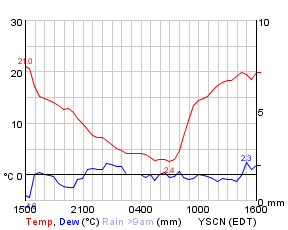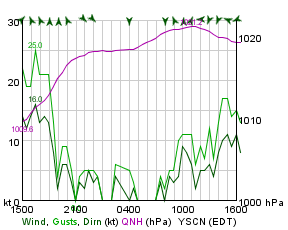Flying Training
Lesson 38: Circuits
Sunday 29 October 2006, 9.30am in Citabria VH-RRW. Instructor: Jim Drinnan
Weather: cool (14°C), clear, wind south to SSW, 6-8 knots gusting to 11 knots
Last lesson for three months, most likely. Late change of mount from MWY (which I'd already preflighted)
 to RRW, as there was a rather taller student with the same timeslot booked, and apparently MWY has more room (same aircraft type, but perhaps more seat adjustment?). The ATIS reported runway 6 in use
(apparently there had already been two changes of runway due to fickle winds) and a 10 knot wind right across the runway. I
should have clicked that we were now doing crosswind circuits, and been glad of the opportunity to practice them, but I
missed my cue.
to RRW, as there was a rather taller student with the same timeslot booked, and apparently MWY has more room (same aircraft type, but perhaps more seat adjustment?). The ATIS reported runway 6 in use
(apparently there had already been two changes of runway due to fickle winds) and a 10 knot wind right across the runway. I
should have clicked that we were now doing crosswind circuits, and been glad of the opportunity to practice them, but I
missed my cue.
We taxiied to 06, passing another aircraft stationary at the point where instructors traditionally get out prior to solo flights, and at the run-up bay Jim intercepted my unthinking intention to face towards the taxiway, and pointed out the direction of the windsock. So I taxiied to the end of the run-up bay and pointed the nose in the direction of the windsock. Following the run-up and at Jim's suggestion, I turned right, over the grass and back onto the taxiway.

My first takeoff was rotten. I didn't anticipate the crosswind (should have held the ailerons into wind), and we were blown to the left nearly right off the runway. After a crosswind take-off the alert pilot will level the wings and immediately hold the rudder into wind to keep on track down the runway centreline. If the wind is from the right, this means a lot of right rudder. I was not alert today.
Although slightly rattled, I did try hard to hold a 70-knot climb, but even so I found myself turning downwind before I reached circuit height, probably because I'd allowed myself to be blown off the centreline on the upwind and had a tailwind on the crosswind leg. My base turn and approach were good, according to Jim, but I was too fast again on the flare, and a gust of wind got under the right wing (which I wasn't holding down) and we experienced a bit of a balloon followed by a harder than normal landing because we were still at flying speed.
My next couple of landings were progressively better as I worked harder at keeping in line with the runway centreline (with rudder) and then holding the wing down, aiming at touching down with the upwind main and tailwheel, but it took me some time to combine the stick forward for takeoff with holding it right to compensate for the crosswind. Jim obviously decided I'd had enough crosswind fun for the day and asked the tower for permission to use runway 10.
So for the remainder of the lesson we threaded our way between traffic for 06, which was interesting itself, especially when we had three Cessnas on base and final. Jim actually had me speed up to fit between the first and second Cessna, which then required some determined sideslipping to reduce speed to 60 knots over the threshold (we don't use flaps much in the Citabrias).
The main thing Jim was trying to teach me was to keep my eyes outside the cockpit on final (ie don't worry about the speed) and to hold off for 2-3 seconds with the stall warning going before landing (in RRW at least, where the stall warning goes off quite early). This requires very fine control over pitch. I believe my efforts were better as the lesson progressed, and the last landing was a nice one to finish on. I felt it actually took me back to where I was on my third session of solo circuits. Goodness knows what happened to my skills in the intervening five months but let's just say that a fortnight's gap between lessons is not working particularly well.
Photos
are coming soon...
Lessons Learned
- Don't just listen to the ATIS, but use the information to plan how to use the controls during the taxi and takeoff - is there a significant crosswind?
- When moving off, throttle back, release the brakes, then throttle up to taxi away. This gives you more control over your taxiing speed than simply releasing the brakes with the throttle at 1000 rpm.
- For the run-up, face into the wind. No exceptions. If facing away from the taxiway, it's permissible to leave the tarmac and taxi over the grass, but watch for gravel.
- If there's a crosswind on take-off, hold aileron into wind and keep straight with rudder (as usual). Stick forward (also as usual, but it feels different when held over to one side). After take-off, level the wings and turn the nose into wind to maintain track down the centreline.
- When the tower is working, the downwind call on a normal circuit is "registration, location and intentions", eg "Romeo Romeo Whisky, downwind, touch and go.". Do not mention the runway - ATC knows which runway is in use! The exception is if you are flying circuits on a different runway from other traffic, eg 10 when others are using 06, as was the case today.
- Make the downwind call early on the downwind leg, to give the controller plenty of time to sequence the traffic.
- Landing in a crosswind is basically the reverse procedure to take-off. Hold the nose into wind to keep tracking down the runway centreline. On short final, straighten up and hold into-wind aileron to avoid being blown off track, keeping the nose straight with rudder. This will probably mean touching down on the upwind main and the tailwheel. Keep the aileron into wind during the rollout and be aware of the wind direction throughout the taxi back to parking.
- Hold off until you are sure the aircraft is ready to land. Don't be impatient to put it on the ground. It will land when it's ready. This might mean a second or two with the stall warning blaring (especially in RRW). So be it.
- When parked and ready for shutdown, consider people nearby before carrying out the shutdown checks. Jim took me to task for, as he put it, "blowing a group of people off their seat". This is the first time I heard that the checks were optional, but Jim was clear that using your discretion in situations like this is good airmanship.
Photos
 Dromader |
 Citabrias |
 Citabrias |
